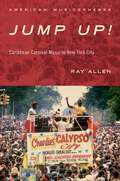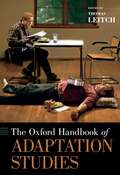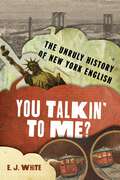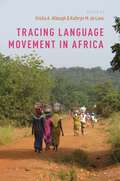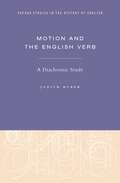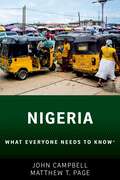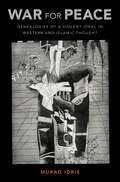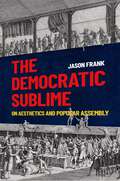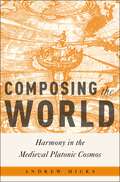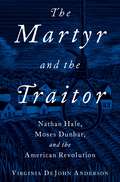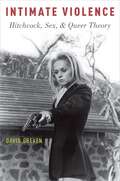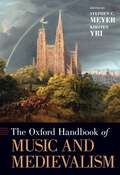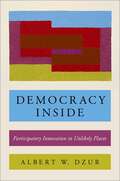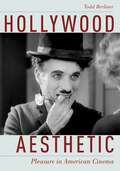- Table View
- List View
Jump Up!: Caribbean Carnival Music in New York (American Musicspheres)
by Ray AllenJump Up! Caribbean Carnival Music in New York City is the first comprehensive history of Trinidadian calypso and steelband music in the diaspora. Carnival, transplanted from Trinidad to Harlem in the 1930s and to Brooklyn in the late 1960s, provides the cultural context for the study. Blending oral history, archival research, and ethnography, Jump Up! examines how members of New York's diverse Anglophile-Caribbean communities forged transnational identities through the self-conscious embrace and transformation of select Carnival music styles and performances. The work fills a significant void in our understanding of how Caribbean Carnival music-specifically calypso, soca (soul/calypso), and steelband-evolved in the second half of the twentieth century as it flowed between its Island homeland and its bourgeoning New York migrant community. Jump Up! addresses the issues of music, migration, and identity head on, exploring the complex cycling of musical practices and the back-and-forth movement of singers, musicians, arrangers, producers, and cultural entrepreneurs between New York's diasporic communities and the Caribbean.
JUMP UP! AM C: Caribbean Carnival Music in New York (American Musicspheres)
by Ray AllenJump Up! Caribbean Carnival Music in New York City is the first comprehensive history of Trinidadian calypso and steelband music in the diaspora. Carnival, transplanted from Trinidad to Harlem in the 1930s and to Brooklyn in the late 1960s, provides the cultural context for the study. Blending oral history, archival research, and ethnography, Jump Up! examines how members of New York's diverse Anglophile-Caribbean communities forged transnational identities through the self-conscious embrace and transformation of select Carnival music styles and performances. The work fills a significant void in our understanding of how Caribbean Carnival music-specifically calypso, soca (soul/calypso), and steelband-evolved in the second half of the twentieth century as it flowed between its Island homeland and its bourgeoning New York migrant community. Jump Up! addresses the issues of music, migration, and identity head on, exploring the complex cycling of musical practices and the back-and-forth movement of singers, musicians, arrangers, producers, and cultural entrepreneurs between New York's diasporic communities and the Caribbean.
The Oxford Handbook of Adaptation Studies (Oxford Handbooks)
by Thomas LeitchThis collection of forty new essays, written by the leading scholars in adaptation studies and distinguished contributors from outside the field, is the most comprehensive volume on adaptation ever published. Written to appeal alike to specialists in adaptation, scholars in allied fields, and general readers, it hearkens back to the foundations of adaptation studies a century and more ago, surveys its ferment of activity over the past twenty years, and looks forward to the future. It considers the very different problems in adapting the classics, from the Bible to Frankenstein to Philip Roth, and the commons, from online mashups and remixes to adult movies. It surveys a dizzying range of adaptations around the world, from Latin American telenovelas to Czech cinema, from Hong Kong comics to Classics Illustrated, from Bollywood to zombies, and explores the ways media as different as radio, opera, popular song, and videogames have handled adaptation. Going still further, it examines the relations between adaptation and such intertextual practices as translation, illustration, prequels, sequels, remakes, intermediality, and transmediality. The volume's contributors consider the similarities and differences between adaptation and history, adaptation and performance, adaptation and revision, and textual and biological adaptation, casting an appreciative but critical eye on the theory and practice of adaptation scholars--and, occasionally, each other. The Oxford Handbook of Adaptation Studies offers specific suggestions for how to read, teach, create, and write about adaptations in order to prepare for a world in which adaptation, already ubiquitous, is likely to become ever more important.
You Talkin' To Me?: The Unruly History of New York English (The Dialects of North America)
by E.J. WhiteFrom paddy wagon to rush hour, New York City has given us a number of our popular words and phrases, along the way fashioning a recognizable dialect all its own. Often imitated and just as often ridiculed, New York English has its own identity, imbued with the rich cultural history of (as New Yorkers tell it) the greatest city in the world. How did this unique language community develop, and how has it shaped the city as we know it today? In You Talkin' to Me?, E.J. White explores the hidden history of English in New York City -- a history that encompasses social class, immigration, culture, economics, and, of course, real estate. She tells entertaining stories of New York's most famous characters, streets, and cultural institutions, from Broadway to the newspaper office to the department store, illuminating a new dimension of the city's landscape. Full of little-known facts -- C-3PO was originally written to have a New York accent; West Side Story was originally going to be East Side Story, about Jewish and Christian New Yorkers; and "confidence man" started in reference to a specific New York City criminal --the book will delight lovers of language and history alike. The history of English in New York is deeply intertwined with the story of a famous city trying to develop its own identity. White's account engages issues of class and social difference; the invisible barriers that separate insiders from outsiders; the war between children who fit in and their parents who do not; and the struggle of being both an immigrant to the city and a New Yorker. Following language from The Bowery to The Bronx, You Talkin' to Me? offers a fascinating account of how language moves and changes-and a new way of understanding the language history, not only of New York, but of the United States.
You Talkin' To Me?: The Unruly History of New York English (The Dialects of North America)
by E.J. WhiteFrom paddy wagon to rush hour, New York City has given us a number of our popular words and phrases, along the way fashioning a recognizable dialect all its own. Often imitated and just as often ridiculed, New York English has its own identity, imbued with the rich cultural history of (as New Yorkers tell it) the greatest city in the world. How did this unique language community develop, and how has it shaped the city as we know it today? In You Talkin' to Me?, E.J. White explores the hidden history of English in New York City -- a history that encompasses social class, immigration, culture, economics, and, of course, real estate. She tells entertaining stories of New York's most famous characters, streets, and cultural institutions, from Broadway to the newspaper office to the department store, illuminating a new dimension of the city's landscape. Full of little-known facts -- C-3PO was originally written to have a New York accent; West Side Story was originally going to be East Side Story, about Jewish and Christian New Yorkers; and "confidence man" started in reference to a specific New York City criminal --the book will delight lovers of language and history alike. The history of English in New York is deeply intertwined with the story of a famous city trying to develop its own identity. White's account engages issues of class and social difference; the invisible barriers that separate insiders from outsiders; the war between children who fit in and their parents who do not; and the struggle of being both an immigrant to the city and a New Yorker. Following language from The Bowery to The Bronx, You Talkin' to Me? offers a fascinating account of how language moves and changes-and a new way of understanding the language history, not only of New York, but of the United States.
Tracing Language Movement in Africa
The great diversity of ethnicities and languages in Africa encourages a vision of Africa as a fragmented continent, with language maps only perpetuating this vision by drawing discrete language groups. In reality, however, most people can communicate with most others within and across linguistic boundaries, even if not in languages taught or learned in schools. Many disciplines have looked carefully at language movement and change on the continent, but their lack of interaction has prevented the emergence of a cohesive picture of African languages. Tracing Language Movement in Africa gathers eighteen scholars together to offer a truly multidisciplinary representation of language in Africa, combining insights from history, archaeology, religion, linguistics, political science, and philosophy. The resulting volume illuminates commonalities and distinctions in these disciplines' understanding of language change and movement in Africa. The volume is empirical -- aiming to represent language more accurately on the continent -- as well as theoretical. It identifies the theories that each discipline uses to make sense of language movement in Africa in plain terms and highlights the themes that cut across all disciplines: how scholars use data, understand boundaries, represent change, and conceptualize power. The volume is organized to reflect differing conceptions of language that arise from its discipline-specific contributions: that is, tendencies to study changes that consolidate language or those that splinter it, viewing languages as whole or in part. Each contribution includes a short explanation of a discipline's theoretical and methodological approaches to language movement and change to ensure that the chapters are accessible to non-specialists, followed by an illustrative empirical case study. This volume will inspire multidisciplinary conversations around the study of language change in Africa, opening new interdisciplinary dialogue and spurring scholars to adapt the questions, data, and method of other disciplines to the problems that animate their own fields.
Tracing Language Movement in Africa
by Ericka A. Albaugh and Kathryn M. de LunaThe great diversity of ethnicities and languages in Africa encourages a vision of Africa as a fragmented continent, with language maps only perpetuating this vision by drawing discrete language groups. In reality, however, most people can communicate with most others within and across linguistic boundaries, even if not in languages taught or learned in schools. Many disciplines have looked carefully at language movement and change on the continent, but their lack of interaction has prevented the emergence of a cohesive picture of African languages. Tracing Language Movement in Africa gathers eighteen scholars together to offer a truly multidisciplinary representation of language in Africa, combining insights from history, archaeology, religion, linguistics, political science, and philosophy. The resulting volume illuminates commonalities and distinctions in these disciplines' understanding of language change and movement in Africa. The volume is empirical -- aiming to represent language more accurately on the continent -- as well as theoretical. It identifies the theories that each discipline uses to make sense of language movement in Africa in plain terms and highlights the themes that cut across all disciplines: how scholars use data, understand boundaries, represent change, and conceptualize power. The volume is organized to reflect differing conceptions of language that arise from its discipline-specific contributions: that is, tendencies to study changes that consolidate language or those that splinter it, viewing languages as whole or in part. Each contribution includes a short explanation of a discipline's theoretical and methodological approaches to language movement and change to ensure that the chapters are accessible to non-specialists, followed by an illustrative empirical case study. This volume will inspire multidisciplinary conversations around the study of language change in Africa, opening new interdisciplinary dialogue and spurring scholars to adapt the questions, data, and method of other disciplines to the problems that animate their own fields.
Motion and the English Verb: A Diachronic Study (Oxford Studies in the History of English)
by Judith HuberIn Motion and the English Verb, a study of the expression of motion in medieval English, Judith Huber provides extensive inventories of verbs used in intransitive motion meanings in Old and Middle English, and discusses these in terms of the manner-salience of early English. Huber demonstrates how several non-motion verbs receive contextual motion meanings through their use in the intransitive motion construction. In addition, she analyzes which verbs and structures are employed most frequently in talking about motion in select Old and Middle English texts, demonstrating that while satellite-framing is stable, the extent of manner-conflation is influenced by text type and style. Huber further investigates how in the intertypological contact with medieval French, a range of French path verbs (entrer, issir, descendre, etc.) were incorporated into Middle English, in whose system of motion encoding they are semantically unusual. Their integration into Middle English is studied in an innovative approach which analyzes their usage contexts in autonomous Middle English texts as opposed to translations from French and Latin. Huber explains how these verbs were initially borrowed not for expressing general literal motion, but in more specific, often metaphorical and abstract contexts. Her study is a diachronic contribution to the typology of motion encoding, and advances research on the process of borrowing and loanword integration.
Motion and the English Verb: A Diachronic Study (Oxford Studies in the History of English)
by Judith HuberIn Motion and the English Verb, a study of the expression of motion in medieval English, Judith Huber provides extensive inventories of verbs used in intransitive motion meanings in Old and Middle English, and discusses these in terms of the manner-salience of early English. Huber demonstrates how several non-motion verbs receive contextual motion meanings through their use in the intransitive motion construction. In addition, she analyzes which verbs and structures are employed most frequently in talking about motion in select Old and Middle English texts, demonstrating that while satellite-framing is stable, the extent of manner-conflation is influenced by text type and style. Huber further investigates how in the intertypological contact with medieval French, a range of French path verbs (entrer, issir, descendre, etc.) were incorporated into Middle English, in whose system of motion encoding they are semantically unusual. Their integration into Middle English is studied in an innovative approach which analyzes their usage contexts in autonomous Middle English texts as opposed to translations from French and Latin. Huber explains how these verbs were initially borrowed not for expressing general literal motion, but in more specific, often metaphorical and abstract contexts. Her study is a diachronic contribution to the typology of motion encoding, and advances research on the process of borrowing and loanword integration.
Nigeria: What Everyone Needs to Know® (What Everyone Needs To Know®)
by John Campbell Matthew T. PageAs the "Giant of Africa" Nigeria is home to about twenty percent of the population of Sub-Saharan Africa, serves as Africa's largest producer of oil and natural gas, comprises Africa's largest economy, and represents the cultural center of African literature, film, and music. Yet the country is plagued by problems that keep it from realizing its potential as a world power. Boko Haram, a radical Islamist insurrection centered in the northeast of the country, is an ongoing security challenge, as is the continuous unrest in the Niger Delta, the heartland of Nigeria's petroleum wealth. There is also persistent violence associated with land and water use, ethnicity, and religion. In Nigeria: What Everyone Needs to Know®, John Campbell and Matthew Page provide a rich contemporary overview of this crucial African country. Delving into Nigeria's recent history, politics, and culture, this volume tackles essential questions related to widening inequality, the historic 2015 presidential election, the persistent security threat of Boko Haram, rampant government corruption, human rights concerns, and the continual conflicts that arise in a country that is roughly half Christian and half Muslim. With its continent-wide influence in a host of areas, Nigeria's success as a democracy is in the fundamental interest of its African neighbors, the United States, and the international community. This book will provide interested readers with an accessible, one-of-a-kind overview of the country.
NIGERIA WENK C: What Everyone Needs to Know® (What Everyone Needs To Know®)
by John Campbell Matthew T. PageAs the "Giant of Africa" Nigeria is home to about twenty percent of the population of Sub-Saharan Africa, serves as Africa's largest producer of oil and natural gas, comprises Africa's largest economy, and represents the cultural center of African literature, film, and music. Yet the country is plagued by problems that keep it from realizing its potential as a world power. Boko Haram, a radical Islamist insurrection centered in the northeast of the country, is an ongoing security challenge, as is the continuous unrest in the Niger Delta, the heartland of Nigeria's petroleum wealth. There is also persistent violence associated with land and water use, ethnicity, and religion. In Nigeria: What Everyone Needs to Know®, John Campbell and Matthew Page provide a rich contemporary overview of this crucial African country. Delving into Nigeria's recent history, politics, and culture, this volume tackles essential questions related to widening inequality, the historic 2015 presidential election, the persistent security threat of Boko Haram, rampant government corruption, human rights concerns, and the continual conflicts that arise in a country that is roughly half Christian and half Muslim. With its continent-wide influence in a host of areas, Nigeria's success as a democracy is in the fundamental interest of its African neighbors, the United States, and the international community. This book will provide interested readers with an accessible, one-of-a-kind overview of the country.
War for Peace: Genealogies of a Violent Ideal in Western and Islamic Thought
by Murad IdrisPeace is a universal ideal, but its political life is a great paradox: "peace" is the opposite of war, but it also enables war. If peace is the elimination of war, then what does it mean to wage war for the sake of peace? What does peace mean when some say that they are committed to it but that their enemies do not value it? Why is it that associating peace with other ideals, like justice, friendship, security, and law, does little to distance peace from war? Although political theory has dealt extensively with most major concepts that today define "the political" it has paid relatively scant critical attention to peace, the very concept that is often said to be the major aim and ideal of humanity. In War for Peace, Murad Idris looks at the ways that peace has been treated across the writings of ten thinkers from ancient and modern political thought, from Plato to Immanuel Kant and Sayyid Qutb, to produce an original and striking account of what peace means and how it works. Idris argues that peace is parasitical in that the addition of other ideals into peace, such as law, security, and friendship, reduces it to consensus and actually facilitates war; it is provincial in that its universalized content reflects particularistic desires and fears, constructions of difference, and hierarchies within humanity; and it is polemical, in that its idealization is not only the product of antagonisms, but also enables hostility. War for Peace uncovers the basis of peace's moralities and the political functions of its idealizations, historically and into the present. This bold and ambitious book confronts readers with the impurity of peace as an ideal, and the pressing need to think beyond universal peace.
War for Peace: Genealogies of a Violent Ideal in Western and Islamic Thought
by Murad IdrisPeace is a universal ideal, but its political life is a great paradox: "peace" is the opposite of war, but it also enables war. If peace is the elimination of war, then what does it mean to wage war for the sake of peace? What does peace mean when some say that they are committed to it but that their enemies do not value it? Why is it that associating peace with other ideals, like justice, friendship, security, and law, does little to distance peace from war? Although political theory has dealt extensively with most major concepts that today define "the political" it has paid relatively scant critical attention to peace, the very concept that is often said to be the major aim and ideal of humanity. In War for Peace, Murad Idris looks at the ways that peace has been treated across the writings of ten thinkers from ancient and modern political thought, from Plato to Immanuel Kant and Sayyid Qutb, to produce an original and striking account of what peace means and how it works. Idris argues that peace is parasitical in that the addition of other ideals into peace, such as law, security, and friendship, reduces it to consensus and actually facilitates war; it is provincial in that its universalized content reflects particularistic desires and fears, constructions of difference, and hierarchies within humanity; and it is polemical, in that its idealization is not only the product of antagonisms, but also enables hostility. War for Peace uncovers the basis of peace's moralities and the political functions of its idealizations, historically and into the present. This bold and ambitious book confronts readers with the impurity of peace as an ideal, and the pressing need to think beyond universal peace.
The Democratic Sublime: On Aesthetics and Popular Assembly
by Jason FrankThe transition from royal to popular sovereignty during the age of democratic revolutions--from 1776 to 1848--entailed not only the reorganization of institutions of governance and norms of political legitimacy, but also a dramatic transformation in the iconography and symbolism of political power. The personal and external rule of the king, whose body was the physical locus of political authority, was replaced with the impersonal and immanent self-rule of the people, whose power could not be incontestably embodied. This posed representational difficulties that went beyond questions of institutionalization and law, extending into the aesthetic realm of visualization, composition, and form. How to make the people's sovereign will tangible to popular judgment was, and is, a crucial problem of democratic political aesthetics. The Democratic Sublime offers an interdisciplinary exploration of how the revolutionary proliferation of popular assemblies--crowds, demonstrations, gatherings of the "people out of doors"--came to be central to the political aesthetics of democracy during the age of democratic revolutions. Jason Frank argues that popular assemblies allowed the people to manifest as a collective actor capable of enacting dramatic political reforms and change. Moreover, Frank asserts that popular assemblies became privileged sites of democratic representation as they claimed to support the voice of the people while also signaling the material plenitude beyond any single representational claim. Popular assemblies continue to retain this power, in part, because they embody that which escapes representational capture: they disrupt the representational space of appearance and draw their power from the ineffability and resistant materiality of the people's will. Engaging with a wide range of sources, from canonical political theorists (Rousseau, Burke, and Tocqueville) to the novels of Hugo, the visual culture of the barricades, and the memoirs of popular insurgents, The Democratic Sublime demonstrates how making the people's sovereign will tangible to popular judgment became a central dilemma of modern democracy, and how it remains so today.
The Democratic Sublime: On Aesthetics and Popular Assembly
by Jason FrankThe transition from royal to popular sovereignty during the age of democratic revolutions--from 1776 to 1848--entailed not only the reorganization of institutions of governance and norms of political legitimacy, but also a dramatic transformation in the iconography and symbolism of political power. The personal and external rule of the king, whose body was the physical locus of political authority, was replaced with the impersonal and immanent self-rule of the people, whose power could not be incontestably embodied. This posed representational difficulties that went beyond questions of institutionalization and law, extending into the aesthetic realm of visualization, composition, and form. How to make the people's sovereign will tangible to popular judgment was, and is, a crucial problem of democratic political aesthetics. The Democratic Sublime offers an interdisciplinary exploration of how the revolutionary proliferation of popular assemblies--crowds, demonstrations, gatherings of the "people out of doors"--came to be central to the political aesthetics of democracy during the age of democratic revolutions. Jason Frank argues that popular assemblies allowed the people to manifest as a collective actor capable of enacting dramatic political reforms and change. Moreover, Frank asserts that popular assemblies became privileged sites of democratic representation as they claimed to support the voice of the people while also signaling the material plenitude beyond any single representational claim. Popular assemblies continue to retain this power, in part, because they embody that which escapes representational capture: they disrupt the representational space of appearance and draw their power from the ineffability and resistant materiality of the people's will. Engaging with a wide range of sources, from canonical political theorists (Rousseau, Burke, and Tocqueville) to the novels of Hugo, the visual culture of the barricades, and the memoirs of popular insurgents, The Democratic Sublime demonstrates how making the people's sovereign will tangible to popular judgment became a central dilemma of modern democracy, and how it remains so today.
Composing the World: Harmony in the Medieval Platonic Cosmos (Critical Conjunctures in Music and Sound)
by Andrew Hicks"We can hear the universe!" This was the triumphant proclamation at a February 2016 press conference announcing that the Laser Interferometer Gravity Observatory (LIGO) had detected a "transient gravitational-wave signal." What LIGO heard in the morning hours of September 14, 2015 was the vibration of cosmic forces unleashed with mind-boggling power across a cosmic medium of equally mind-boggling expansiveness: the transient ripple of two black holes colliding more than a billion years ago. The confirmation of gravitational waves sent tremors through the scientific community, but the public imagination was more captivated by the sonic translation of the cosmic signal, a sound detectable only through an act of carefully attuned listening. As astrophysicist Szabolcs Marka remarked, "Until this moment, we had our eyes on the sky and we couldn't hear the music. The skies will never be the same." Taking in hand this current "discovery" that we can listen to the cosmos, Andrew Hicks argues that sound--and the harmonious coordination of sounds, sources, and listeners--has always been an integral part of the history of studying the cosmos. Composing the World charts one constellation of musical metaphors, analogies, and expressive modalities embedded within a late-ancient and medieval cosmological discourse: that of a cosmos animated and choreographed according to a specifically musical aesthetic. The specific historical terrain of Hicks' discussion centers upon the world of twelfth-century philosophy, and from there he offers a new intellectual history of the role of harmony in medieval cosmological discourse, a discourse which itself focused on the reception and development of Platonism. Hicks illuminates how a cosmological aesthetics based on the "music of the spheres" both governed the moral, physical, and psychic equilibrium of the human, and assured the coherence of the universe as a whole. With a rare convergence of musicological, philosophical, and philological rigor, Hicks presents a narrative tour through medieval cosmology with reflections on important philosophical movements along the way, raising connections to Cartesian dualism, Uexküll's theoretical biology, and Deleuze and Guattari's musically inspired language of milieus and (de)territorialization. Hicks ultimately suggests that the models of musical cosmology popular in late antiquity and the twelfth century are relevant to our modern philosophical and scientific undertakings. Impeccably researched and beautifully written, Composing the World will resonate with a variety of readers, and it encourages us to rethink the role of music and sound within our greater understanding of the universe.
Composing the World: Harmony in the Medieval Platonic Cosmos (Critical Conjunctures in Music and Sound)
by Andrew Hicks"We can hear the universe!" This was the triumphant proclamation at a February 2016 press conference announcing that the Laser Interferometer Gravity Observatory (LIGO) had detected a "transient gravitational-wave signal." What LIGO heard in the morning hours of September 14, 2015 was the vibration of cosmic forces unleashed with mind-boggling power across a cosmic medium of equally mind-boggling expansiveness: the transient ripple of two black holes colliding more than a billion years ago. The confirmation of gravitational waves sent tremors through the scientific community, but the public imagination was more captivated by the sonic translation of the cosmic signal, a sound detectable only through an act of carefully attuned listening. As astrophysicist Szabolcs Marka remarked, "Until this moment, we had our eyes on the sky and we couldn't hear the music. The skies will never be the same." Taking in hand this current "discovery" that we can listen to the cosmos, Andrew Hicks argues that sound--and the harmonious coordination of sounds, sources, and listeners--has always been an integral part of the history of studying the cosmos. Composing the World charts one constellation of musical metaphors, analogies, and expressive modalities embedded within a late-ancient and medieval cosmological discourse: that of a cosmos animated and choreographed according to a specifically musical aesthetic. The specific historical terrain of Hicks' discussion centers upon the world of twelfth-century philosophy, and from there he offers a new intellectual history of the role of harmony in medieval cosmological discourse, a discourse which itself focused on the reception and development of Platonism. Hicks illuminates how a cosmological aesthetics based on the "music of the spheres" both governed the moral, physical, and psychic equilibrium of the human, and assured the coherence of the universe as a whole. With a rare convergence of musicological, philosophical, and philological rigor, Hicks presents a narrative tour through medieval cosmology with reflections on important philosophical movements along the way, raising connections to Cartesian dualism, Uexküll's theoretical biology, and Deleuze and Guattari's musically inspired language of milieus and (de)territorialization. Hicks ultimately suggests that the models of musical cosmology popular in late antiquity and the twelfth century are relevant to our modern philosophical and scientific undertakings. Impeccably researched and beautifully written, Composing the World will resonate with a variety of readers, and it encourages us to rethink the role of music and sound within our greater understanding of the universe.
MART & TR NAT HAL, MOS DUN & AMER REV C: Nathan Hale, Moses Dunbar, and the American Revolution
by Virginia DeJohn AndersonIn September 1776, two men from Connecticut each embarked on a dangerous mission. One of the men, a soldier disguised as a schoolmaster, made his way to British-controlled Manhattan and began furtively making notes and sketches to bring back to the beleaguered Continental Army general, George Washington. The other man traveled to New York to accept a captain's commission in a loyalist regiment before returning home to recruit others to join British forces. Neither man completed his mission. Both met their deaths at the end of a hangman's rope, one executed as a spy for the American cause and the other as a traitor to it. Neither Nathan Hale nor Moses Dunbar deliberately set out to be a revolutionary or a loyalist, yet both suffered the same fate. They died when there was every indication that Britain would win the American Revolution. Had that been the outcome, Dunbar, convicted of treason and since forgotten, might well be celebrated as a martyr. And Hale, caught spying on the British, would likely be remembered as a traitor, rather than a Revolutionary hero. In The Martyr and the Traitor, Virginia DeJohn Anderson offers an intertwined narrative of men from very similar backgrounds and reveals how their relationships within their families and communities became politicized as the imperial crisis with Britain erupted. She explores how these men forged their loyalties in perilous times and believed the causes for which they died to be honorable. Through their experiences, The Martyr and the Traitor illuminates the impact of the Revolution on ordinary lives and how the stories of patriots and loyalists were remembered and forgotten after independence.
INTIMATE VIOLENCE C: Hitchcock, Sex, and Queer Theory
by David GrevenIntimate Violence explores the consistent cold war in Hitchcock's films between his heterosexual heroines and his queer characters, usually though not always male. Decentering the authority of the male hero, Hitchcock's films allow his female and queer characters to vie for narrative power, often in conflict with one another. These conflicts eerily echo the tense standoff between feminism and queer theory. From a reparative psychoanalytic perspective, David Greven merges queer and feminist approaches to Hitchcock. Using the theories of Melanie Klein, Greven argues that Hitchcock's work thematizes a constant battle between desires to injure and to repair the loved object. Greven develops a theory of sexual hegemony. The feminine versus the queer conflict, as he calls it, in Hitchcock films illuminates the shared but rivalrous struggles for autonomy and visibility on the part of female and queer subjects. The heroine is vulnerable to misogyny, but she often gains an access to agency that the queer subject longs for, mistaking her partial autonomy for social power. Hitchcock's queer personae, however, wield a seductive power over his heterosexual subjects, having access to illusion and masquerade that the knowledge-seeking heroine must destroy. Freud's theory of paranoia, understood as a tool for the dissection of cultural homophobia, illuminates the feminine versus the queer conflict, the female subject position, and the consistent forms of homoerotic antagonism in the Hitchcock film. Through close readings of such key Hitchcock works as North by Northwest, Psycho, Strangers on a Train, Spellbound, Rope, Marnie, and The Birds, Greven explores the ongoing conflicts between the heroine and queer subjects and the simultaneous allure and horror of same-sex relationships in the director's films.
The Oxford Handbook of Music and Medievalism (Oxford Handbooks)
The Oxford Handbook of Music and Medievalism provides a snapshot of the diverse ways in which medievalism--the retrospective immersion in the images, sounds, narratives, and ideologies of the European Middle Ages--powerfully transforms many of the varied musical traditions of the last two centuries. Thirty-three chapters from an international group of scholars explore topics ranging from the representation of the Middle Ages in nineteenth-century opera to medievalism in contemporary video game music, thereby connecting disparate musical forms across typical musicological boundaries of chronology and geography. While some chapters focus on key medievalist works such as Orff's Carmina Burana or Peter Jackson's Lord of the Rings films, others explore medievalism in the oeuvre of a single composer (e.g. Richard Wagner or Arvo Pärt) or musical group (e.g. Led Zeppelin). The topics of the individual chapters include both well-known works such as John Boorman's film Excalibur and also less familiar examples such as Eduard Lalo's Le Roi d'Ys. The authors of the chapters approach their material from a wide array of disciplinary perspectives, including historical musicology, popular music studies, music theory, and film studies, examining the intersections of medievalism with nationalism, romanticism, ideology, nature, feminism, or spiritualism. Taken together, the contents of the Handbook develop new critical insights that venture outside traditional methodological constraints and provide a capstone and point of departure for future scholarship on music and medievalism.
The Oxford Handbook of Music and Medievalism (Oxford Handbooks)
by Stephen C. Meyer Kirsten YriThe Oxford Handbook of Music and Medievalism provides a snapshot of the diverse ways in which medievalism--the retrospective immersion in the images, sounds, narratives, and ideologies of the European Middle Ages--powerfully transforms many of the varied musical traditions of the last two centuries. Thirty-three chapters from an international group of scholars explore topics ranging from the representation of the Middle Ages in nineteenth-century opera to medievalism in contemporary video game music, thereby connecting disparate musical forms across typical musicological boundaries of chronology and geography. While some chapters focus on key medievalist works such as Orff's Carmina Burana or Peter Jackson's Lord of the Rings films, others explore medievalism in the oeuvre of a single composer (e.g. Richard Wagner or Arvo Pärt) or musical group (e.g. Led Zeppelin). The topics of the individual chapters include both well-known works such as John Boorman's film Excalibur and also less familiar examples such as Eduard Lalo's Le Roi d'Ys. The authors of the chapters approach their material from a wide array of disciplinary perspectives, including historical musicology, popular music studies, music theory, and film studies, examining the intersections of medievalism with nationalism, romanticism, ideology, nature, feminism, or spiritualism. Taken together, the contents of the Handbook develop new critical insights that venture outside traditional methodological constraints and provide a capstone and point of departure for future scholarship on music and medievalism.
Democracy Inside: Participatory Innovation in Unlikely Places
by Albert W. DzurIn our current era of deep distrust in our politics and political institutions, there is also a pervasive sense that social problems are so overwhelmingly complex that it is virtually impossible to solve them. In Democracy Inside, Albert W. Dzur looks at recent instances of effective citizen action across the United States to develop a grounded political theory of democratic change, one in which citizens effectively engage with institutions. Drawing on qualitative interviews with practitioners involved in democratic schools, restorative and community justice, and collaborative city governance, Dzur stresses that we need to turn to ordinary, daily life and focus on how "democratic professionals" are breaking down barriers and bring people into decision-making processes at the granular level. These reformers are not transforming high politics or national-scale institutions, but they have been effective at changing the routine, everyday practices where people live and work. As Democracy Inside shows, if we really want to expand the democracy and build citizen engagement intensity in American life, we need to look beyond traditional politics and transform our classrooms, courtrooms, and offices into accessible civic spaces.
DEMOCRACY INSIDE C: Participatory Innovation in Unlikely Places
by Albert W. DzurIn our current era of deep distrust in our politics and political institutions, there is also a pervasive sense that social problems are so overwhelmingly complex that it is virtually impossible to solve them. In Democracy Inside, Albert W. Dzur looks at recent instances of effective citizen action across the United States to develop a grounded political theory of democratic change, one in which citizens effectively engage with institutions. Drawing on qualitative interviews with practitioners involved in democratic schools, restorative and community justice, and collaborative city governance, Dzur stresses that we need to turn to ordinary, daily life and focus on how "democratic professionals" are breaking down barriers and bring people into decision-making processes at the granular level. These reformers are not transforming high politics or national-scale institutions, but they have been effective at changing the routine, everyday practices where people live and work. As Democracy Inside shows, if we really want to expand the democracy and build citizen engagement intensity in American life, we need to look beyond traditional politics and transform our classrooms, courtrooms, and offices into accessible civic spaces.
Hollywood Aesthetic: Pleasure in American Cinema
by Todd BerlinerHollywood makes the most widely successful pleasure-giving artworks the world has ever known. The industry operates under the assumption that pleasurable aesthetic experiences, among huge populations, translate into box office success. With that goal in mind, Hollywood has systematized the delivery of aesthetic pleasure, packaging and selling it on a massive scale. In Hollywood Aesthetic, Todd Berliner accounts for the chief attraction of Hollywood cinema worldwide: its entertainment value. The book examines films such as City Lights and Goodfellas that have earned aesthetic appreciation from both fans and critics. But it also studies some curious outliers, cult films, and celebrated Hollywood experiments, such as The Killing and Starship Troopers. And it demonstrates that even ordinary popular films, from Tarzan and His Mate to Rocky III, as well as action blockbusters, like Die Hard and The Dark Knight, offer aesthetic pleasure to mass audiences. Hollywood Aesthetic explains how Hollywood engages viewers by satisfying their aesthetic desires. Visit the companion website at www.oup.com/us/hollywoodaesthetic
Hollywood Aesthetic: Pleasure in American Cinema
by Todd BerlinerHollywood makes the most widely successful pleasure-giving artworks the world has ever known. The industry operates under the assumption that pleasurable aesthetic experiences, among huge populations, translate into box office success. With that goal in mind, Hollywood has systematized the delivery of aesthetic pleasure, packaging and selling it on a massive scale. In Hollywood Aesthetic, Todd Berliner accounts for the chief attraction of Hollywood cinema worldwide: its entertainment value. The book examines films such as City Lights and Goodfellas that have earned aesthetic appreciation from both fans and critics. But it also studies some curious outliers, cult films, and celebrated Hollywood experiments, such as The Killing and Starship Troopers. And it demonstrates that even ordinary popular films, from Tarzan and His Mate to Rocky III, as well as action blockbusters, like Die Hard and The Dark Knight, offer aesthetic pleasure to mass audiences. Hollywood Aesthetic explains how Hollywood engages viewers by satisfying their aesthetic desires. Visit the companion website at www.oup.com/us/hollywoodaesthetic
